![]()
![]()
![]()
Use LEFT and RIGHT arrow keys to navigate between flashcards;
Use UP and DOWN arrow keys to flip the card;
H to show hint;
A reads text to speech;
24 Cards in this Set
- Front
- Back
|
15. Polygenic Inheritance |
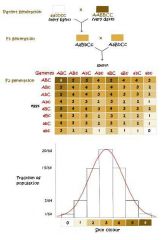
Occurs when one characteristic is controlled by two or more genes. Often the genes are large in quantity but small in effect. |
|
|
1. Gregor Mendel |
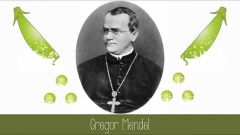
Father of modern genetics. Studied large samples of plants and applied statistical analysis to his data. Stated that characteristics are inherited as discrete units now known as genes. |
|
|
2. Inheritance |
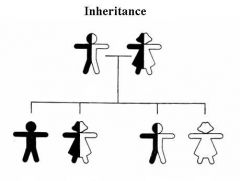
Heredity, or inheritance in the biological sense, refers to the physical features that offspring inherit from their parents, such as eye color, shape of nose and mouth, height and other distinguishing physical characteristics. |
|
|
3. Chromosomes |

A threadlike structure of nucleic acids and protein found in the nucleus of most living cells, carrying genetic information in the form of genes. |
|
|
4. Genes |
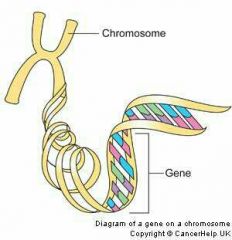
A unit of heredity that is transferred from a parent to offspring and is held to determine some characteristic of the offspring. |
|
|
5. Alleles |
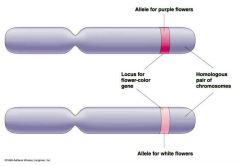
One of two or more alternative forms of a gene that arise by mutation and are found at the same place on a chromosome. |
|
|
6. Probability |
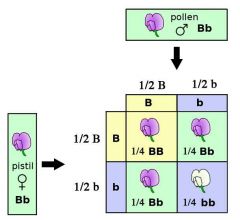
Probability is used to measure the chances or likelihood of an event to occur, a hypothesis being correct, or a scientific prediction being true. In biology, it is used in predicting the outcome of a genetic cross or of a random experiment. |
|
|
7. Law of Dominance |
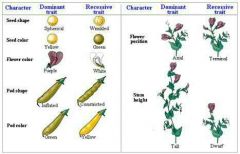
Mendel's third law states that one of the factors for a pair of inherited traits will be dominant and the other recessive, unless both factors are recessive. |
|
|
8. Law of Segregation |
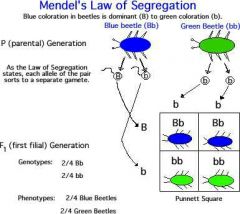
One of these principles, now called Mendel's law of segregation, states that allele pairs separate or segregate during gamete formation, and randomly unite at fertilization. |
|
|
9. Monohybrid Cross |
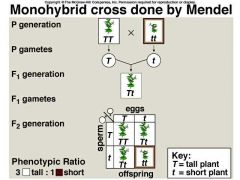
A mating between two individuals with different alleles at one genetic locus of interest. The character(s) being studied in a monohybrid cross are governed by two or multiple alleles for a single locus. |
|
|
10. Backcross/Testcross |
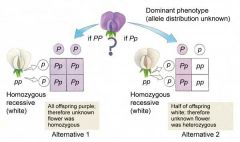
Cross (a hybrid) with one of its parents or an organism with the same genetic characteristics as one of the parents. |
|
|
11. Law of Independent Assortment |
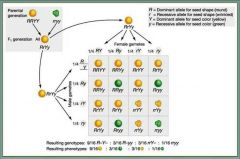
The principle, originated by Gregor Mendel, stating that when two or more characteristics are inherited, individual hereditary factors assort independently during gamete production, giving different traits an equal opportunity of occurring together. |
|
|
12. Incomplete Dominance |
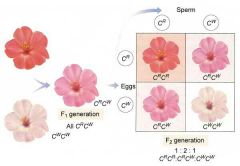
A form of intermediate inheritance in which one allele for a specific trait is not completely expressed over its paired allele. This results in a third phenotype in which the expressed physical trait is a combination of the phenotypes of both alleles. |
|
|
13. Codominance |
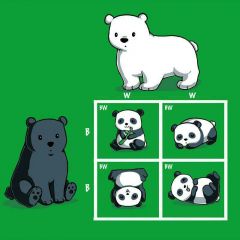
Alleles that are masked or hidden by dominant alleles are known as recessive alleles. In some situations, both alleles are expressed equally. A genetic scenario where neither allele is dominant or recessive and both get expressed is known as codominance. |
|
|
14. Multiple Alleles |
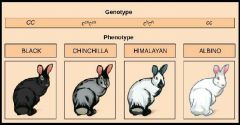
Three or more alternative forms of a gene (alleles) that can occupy the same locus. However, only two of the alleles can be present in a single organism. |
|
|
15. Polygenic Inheritance |

Occurs when one characteristic is controlled by two or more genes. Often the genes are large in quantity but small in effect. |
|
|
16. Expressivity |
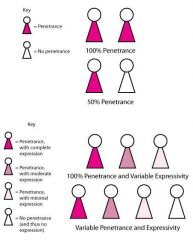
A term used in genetics to describe the degree to which an individual exhibits a trait or a genetic mutation. |
|
|
17. Linked Genes |
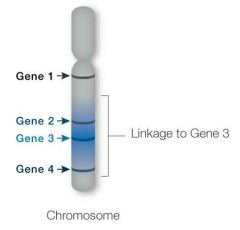
When two genes are close together on the same chromosome, they do not assort independently and are said to be linked. Whereas genes located on different chromosomes assort independently and have a recombination frequency of 50%, linked genes have a recombination frequency that is less than 50%. |
|
|
18. Map Units |
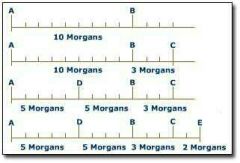
In genetics, a centimorgan (abbreviated cM) or map unit (m.u.) is a unit for measuring genetic linkage. It is defined as the distance between chromosome positions (also termed loci or markers) for which the expected average number of intervening chromosomal crossovers in a single generation is 0.01. |
|
|
19. Linkage Map |
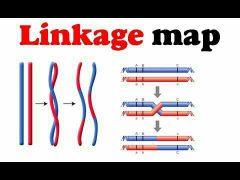
A map of the genes on a chromosome based on linkage analysis. A linkage map does not show the physical distances between genes but rather their relative positions, as determined by how often two gene loci are inherited together. |
|
|
20. Sex-Linked Traits |
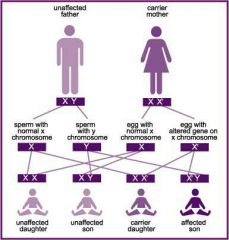
In humans, red-green colorblindness is a recessive sex-linked trait. It is found on the X chromosome, not the Y. Because, males only have one X chromosome, they have a much greater chance of having red-green colorblindness. Females would have to be homozygous recessive in order to have red-green colorblindness. |
|
|
21. Pedigree |

An ancestral line or chart depicting the lineage or descent of an individual. |
|
|
22. Barr Body |
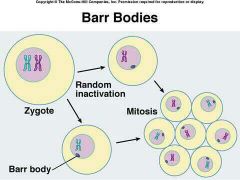
A small, densely staining structure in the cell nuclei of female mammals, consisting of a condensed, inactive X chromosome. It is regarded as diagnostic of genetic femaleness. |
|
|
23. Genomic Imprinting |

The epigenetic phenomenon by which certain genes are expressed in a parent-of-origin-specific manner. If the allele inherited from the father is imprinted, it is thereby silenced, and only the allele from the mother is expressed. |

